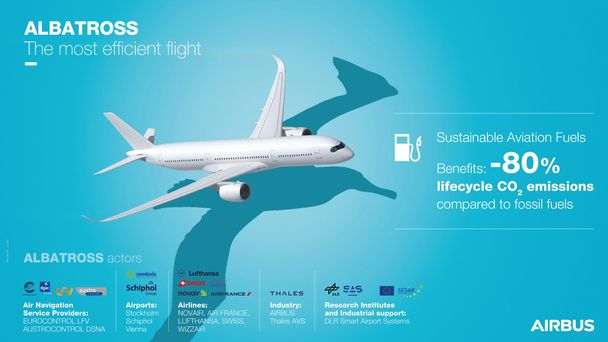Seeking the most efficient flight – Episode 3: Sustainable Aviation Fuels (SAF)

D
id you know that increasing the use of Sustainable Aviation Fuel (SAF) has the potential to support the aviation industry’s long-term climate goal of net-zero carbon emissions by 2050? This is the idea behind SESAR’s Albatross* SAF work package Airbus is currently working on.
*: Please note that ALBATROSS is a separate initiative from the Airbus “AlbatrossOne” wing project.
In this third instalment of our series of articles on SESAR’s Albatross very large demonstration (VLD) project which will explore and demonstrate the most fuel-efficient flights through a series of gate-to-gate live trials across Europe, we put the spotlight on the work package for Sustainable Aviation Fuel (SAF) led by Airbus.
Towards net-zero carbon emissions by 2050
SAF is one of the aviation industry’s four decarbonisation pillars, which also include improved technologies, market-based measures, more efficient aircraft operations and improved infrastructure. It has the potential to support the aviation industry’s long-term goal of net-zero carbon emissions by 2050. Increasing the use of SAF in all commercial aircraft is therefore a necessity. To support this trend, some Albatross live trials will use SAF. Overall this is expected to contribute to the promotion of SAF, as well as support the emergence of a market for SAF, encouraging future investments while helping to maintain a level playing field for aviation.
The actual fuel to be used as part of Albatross trials will be a “JetA/A1” SAF blend. It will be composed of synthetic and conventional blend components.
The uptake of SAF in Albatross VLD will help to ‘oil the wheels’ of the entire SAF value chain, from the production plant to point of use. It will also provide an opportunity for stakeholders to explore the potential chain of custody for SAF integration, from direct use to ‘dematerialisation’. Last but not least, it will help promote decarbonisation solutions by illustrating how combining multiple decarbonisation measures can contribute to climate-neutral flight.
Albatross trials “Book-and-Claim” concept
Presently, only a few airports worldwide actually have supplies of SAF on site. This means only airlines flying routes via those airports will be able to have their aircraft refuelled with SAF. However, other airlines would also help to further popularise the uptake of SAF thanks to a proposed “book-and-claim” (B&C) concept. Currently under definition with the project’s stakeholders, Book & Claim would enable any airline to ‘book’ SAF, even if they will not have aircraft physically stationed at an airport where there are actual supplies of SAF. By booking a specific volume of SAF, other airlines, who do have aircraft stationed at another airport where SAF is present would still be able to have their aircraft refuelled with SAF without the airline necessarily knowing it. Mattia Nurisso, the Airbus project leader in Albatross, explains how book-and-claim -- to be demonstrated at a concept level in Albatross -- could work, if ultimately adopted into an international agreed framework: “With book-and-claim, only the recipient airline paying the price premium would be entitled to account for that SAF by means of a 'sustainability certificate' delivered by the certified authority. Once this certificate is delivered, it would be retired from the system to ensure that no-one else can claim it.” Importantly, by defining and elaborating the proper mechanisms today, we can ensure the traceability and reliability of the SAF initially acquired by the airlines even if it is not physically present on board the aircraft. This is essential to standardisation, and ensuring double-counting doesn’t occur. “The key aim overall is that now Airbus together with its Albatross partners can demonstrate how we could enable more airlines to benefit from SAF in their operations. And the SESAR Albatross trials and the B&C concept should help us by making some real progress towards that,” concludes Mattia. |